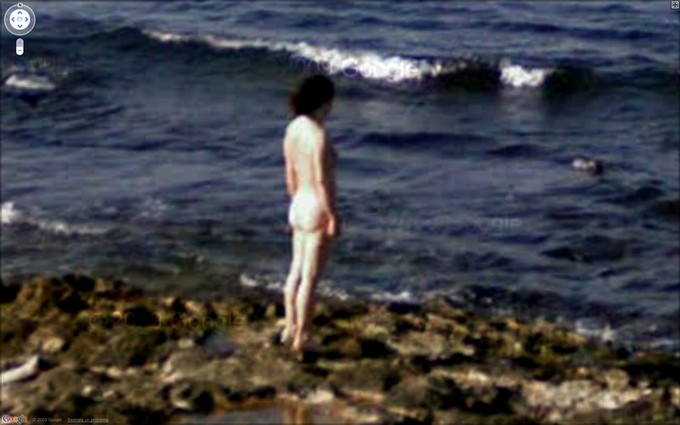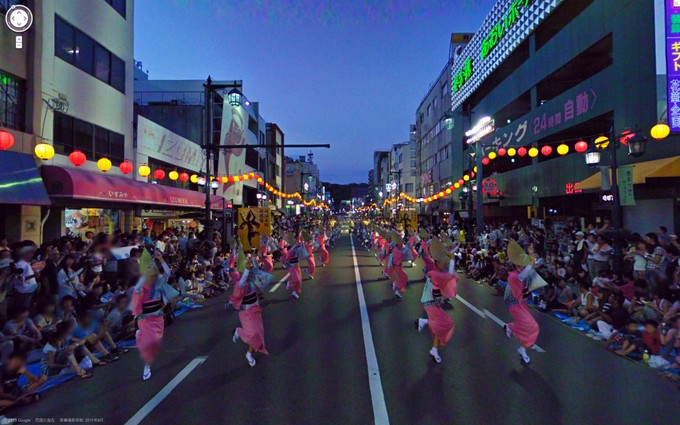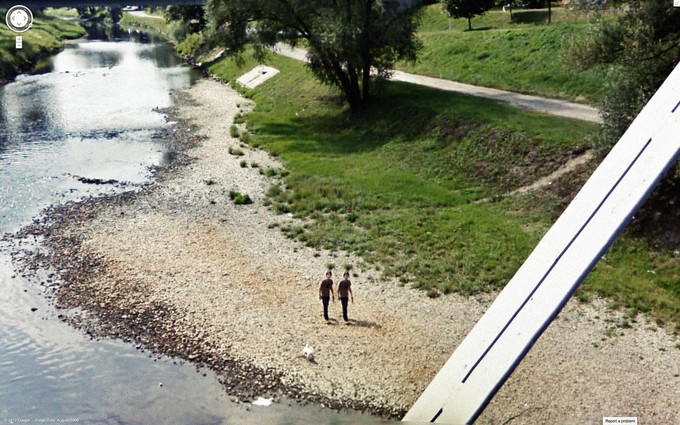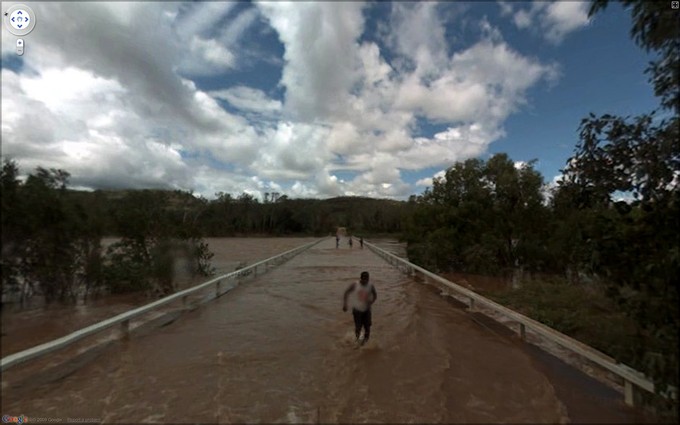This text accompanies the presentation of Nine Eyes of Google Street View as part of the online exhibition Net Art Anthology.
In 2007, Google launched Street View, a new feature for Google Maps. For the first time, users could leave the map’s default bird’s-eye view perspective, and enter a 360° immersive street-level world. To build this world, Google launched a fleet of cars that used automated multi-lens digital cameras to photograph every street, highway, and alley. The images were then analyzed, altered and corrected, and stitched together to produce Street View’s navigable three-dimensional environment.
Shortly after Street View’s release, artist Jon Rafman began to explore its world, taking screenshots of scenes he found along the way, which laid the foundation for the collection Nine Eyes (2008-ongoing). In terms of form, Nine Eyes of Google Street View is perhaps best known as a Tumblr (http://9-eyes.com/) but the images have also been printed and exhibited physically (as in the exhibition “Mirror Sites” at M+B in 2012), as well as remixed into other works, such as You, the World and I (2010). It is important to note that Rafman was not alone in his Street View travels, as many artists and photographers—such as Michael Wolf or Douglas Rickard—were pursuing concurrent projects. What distinguishes Nine Eyes of Google Street View, however, is its pursuit of the sublime in the postinternet age.





Rafman’s approach to photography is unmistakably postinternet. Following the definition formulated in Artie Vierkant’s essay “The Image Object Post-Internet,” postinternet art refers to objects and images that have been created “with concern to their particular materiality as well as their vast variety of methods of presentation and dissemination.” For Vierkant, this type of production is always inherently informed by certain characteristics of life under Web 2.0 such as “the collapse of physical space in networked culture, and the infinite reproducibility and mutability of digital materials.” Google Street View, as an attempt to fully map physical space onto the digital screen, provides an exemplary source material for such work, since it presents life itself in the same way Guthrie Lonergan described “Internet Aware” art: “when the photo of the art object is more widely dispersed [and] viewed than the object itself.”
As postinternet photography, the images in Nine Eyes of Google Street View testify above all to the processes of their own making and dissemination. There is no coherent subject matter unifying the images. Certain themes recur, such as glitches in the stitching system or people giving the finger to the camera, but what organizes the photographs together into one single work is simply that they have been selected from Street View during one of the artist’s marathon surfing sessions. Rafman highlights the digital aspects of his photographs—such as pixelation, watermarks, and the navigational interface which appears in nearly every image—but this never detracts from the sense that the photographs portray something real. Instead, they declare the extent to which offline life is always already structured by the online. This is what leads Geoff Dyer to describe Nine Eyes of Google Street View as giving the impression that not only is Rafman not an “old-school photographer,” but that it almost seems as if he has never even been outdoors, and that “his knowledge of the world derives entirely from representations of it.”



The sense of slipperiness between these two modes is furthered by the work’s form as a blog, which acknowledges and facilitates the sharing of the images. By organizing the photographs in a Tumblr, where users frequently reblog and circulate images produced by others, Nine Eyes of Google Street View never exists in a stable state, and instead takes its potential circulation as inherent to the work. The fact that Nine Eyes of Google Street View remains ongoing—despite last being updated in 2014—reflects the temporality of the blog, where there is never a clear sense of finality, since as long as the blog still exists there is always the capability for one more post. Online image sharing is also evidenced by the physical prints Rafman makes, which detail how an image spreads, transitioning from the screen to the gallery, before once more returning to the screen through exhibition photographs.
Like much postinternet art, Nine Eyes of Google Street View does not take a compelling critical stance, but for Rafman, this is intentional.1Nine Eyes of Google Street View may at times gesture towards critique—it shares a name, for example, with an intelligence sharing alliance composed of nine countries, bringing to mind issues of mass surveillance—but its focus lies elsewhere, in aesthetic experience. As Rafman states in a 2011 interview with AIDS 3D, “Aesthetic experience for me is self-justifying… it is very important for me to maintain a separation between art… and politics and critical theory.” While most postinternet art draws upon contemporary corporate aesthetics, Rafman instead draws influence from the romantic period, bringing the search for the sublime into the virtual realm.2

Though the concept of the sublime dates back to classical antiquity, it came to renewed prominence in the romantic period due to the writings of Immanuel Kant, who devoted a lengthy section his Critique of Judgement to the topic. For Kant, the sublime is a sensation in the mind that is aroused through a specific type of encounter. It is a carefully balanced sensation, simultaneously evoking displeasure—caused by an awareness of inadequacy and the limitations of human thought—and pleasure, “arising from this very judgment of the inadequacy of the greatest faculty of sense being in accord with ideas of reason.” In order to evoke this feeling, the subject must encounter a seemingly limitless, violent, though not harmful, object. In Kant’s schema the ideal object of the sublime is nature, since it is an outside to the enlightenment society in which Kant lived, governed by reason and logic. In its most chaotic, violent, or terrifying forms it pushes the subject into a sublime encounter, initially evoking the limitations of man and society, but ultimately leading to joy through the mind’s capability to overcome this displeasure. More precisely, for Kant the sublime is “an object (of nature) the representation of which determines the mind to regard the elevation of nature beyond our reach as equivalent to a presentation of ideas.”3
Though Kant privileges Nature, as historical moments shift, so too do the objects of the sublime. In his characterization of the postmodern period, Fredric Jameson updates the enlightenment concept of the sublime into what he terms the postmodern or technological sublime. Since “the other of our society is in that sense no longer Nature at all,” Jameson replaces it with technology, as it “seems to offer some privileged representational shorthand for grasping a network of power and control even more difficult for our minds and imaginations to grasp: the whole new decentered global network of the third stage of capital itself.”4 Jameson wrote, however, at a time when global networks of communication like the internet were novel and still in their infancy. How can the postmodern sublime be conveyed through postinternet art, when “the internet is less a novelty and more a banality”?

The key to the sublime in Rafman’s work lies in the way the indifferent, mechanical gaze of the automated Street View camera renders even the most banal moments as other, re-presenting life as something alien to the human. Rafman describes seeing in Street View as “looking at a memory that nobody really had”; the scenes depicted in the images may be recognizable and banal, but the images themselves are nonetheless foreign. In many of Rafman’s photos, this distance between the viewer and life is laid all the more bare by his inclusion of the “Report a Problem” button in many of the Nine Eyes of Google Street View images. Here, the only element that even approaches some form of reciprocity or communication between the viewer and the networks in which they are enmeshed is made viewable, but inoperable. The viewer is held at a distance, experiencing the sublime as they confront the absolute otherness of Street View.
 Beyond the camera itself, the sheer scale of the Street View project strengthens the sense of the sublime in Rafman’s images. As Luc Vincent, an engineer who pioneered the Street View project, states, Google’s intention is to “paint the world,” at the resolution of “about one pixel to the inch.” The sheer ambition of the aim of such goal—not to mention the resources necessary for such an undertaking—exceeds the rational, and even approaches the limits of the positivist dominion inherent in mapping. The images ofNine Eyes of Google Street View place the viewer on the edges of the map, faced with something vast and ungraspable. Instead of making the world known, Rafman reveals how Street View renders the sublime.
Beyond the camera itself, the sheer scale of the Street View project strengthens the sense of the sublime in Rafman’s images. As Luc Vincent, an engineer who pioneered the Street View project, states, Google’s intention is to “paint the world,” at the resolution of “about one pixel to the inch.” The sheer ambition of the aim of such goal—not to mention the resources necessary for such an undertaking—exceeds the rational, and even approaches the limits of the positivist dominion inherent in mapping. The images ofNine Eyes of Google Street View place the viewer on the edges of the map, faced with something vast and ungraspable. Instead of making the world known, Rafman reveals how Street View renders the sublime.
Notes:
1. See “The Perils of Post-Internet Art” by Brian Droitcour
2. Rafman’s interest in the sublime is evidenced in exhibitions such as In Search for the Virtual Sublime II at China Art Objects in Los Angeles. The sublime as an aesthetic concern can also be seen in Kool-Aid Man in Second Life (2008-2011), produced contemporaneously to Nine Eyes of Google Street View. In many of the videos and images that make up the work, the Kool-Aid Man, the artist’s avatar in Second Life, is shown alone, starring into the vast abyss of the digital world, bringing to mind Caspar David Friedrich’s Wanderer above the Sea of Fog (1818).
3. Kant, Immanuel. Critique of Judgement. Trans. James Creed Meredith. New York: Oxford University Press, 2007.
4. Jameson, Fredric. Postmodernism: or, the Cultural Logic of Late Capitalism. Durham: Duke University Press, 1991.
